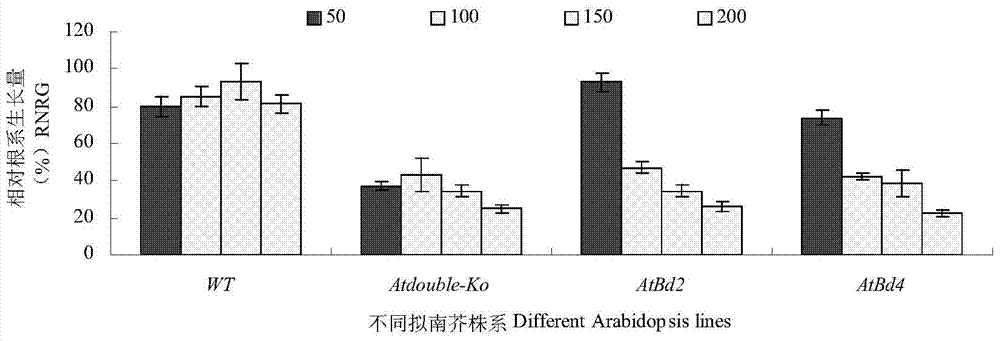Application of Peanut ahfrdl1 Gene in Improving Plant Resistance to Aluminum Toxic Stress
A peanut and genetic technology, applied in the field of genetic engineering, to achieve the effect of improving yield and quality and having broad application prospects
- Summary
- Abstract
- Description
- Claims
- Application Information
AI Technical Summary
Problems solved by technology
Method used
Image
Examples
Embodiment 1
[0048] Cloning of Example 1 Peanut AhFRDL1 Gene
[0049] (1) Hydroponic cultivation of peanuts
[0050] Peanut seeds Luhua 14 (purchased from the Chinese Academy of Agricultural Sciences) were sterilized with 10% hydrogen peroxide for 30 minutes, cleaned, placed in saturated calcium sulfate solution for about 8 hours, and ventilated to avoid light. Then place them in a tray covered with absorbent paper, pour an appropriate amount of water, and place them in an artificial cultivation room in the dark. The culture room was set at 30°C for 14 hours with light and 22°C for 10 hours with darkness. About 1 day after the peanuts sprouted small buds, they were transferred to quartz sand for cultivation, and after 2 leaves grew, they were transferred to hydroponic nutrient solution for cultivation. The formula of hydroponic nutrient solution is as follows: KH 2 PO 4 (0.5mM), K 2 SO 4 (0.75mM), KCl (0.1mM), MgSO 4· 7H 2 O (0.65mM), CaSO 4· 2H 2 O(2mM), H 3 BO 3 (1μM), MnSO ...
Embodiment 2
[0060] The construction of embodiment 2 recombinant expression vector
[0061] 1. Build the carrier
[0062](1) Add restriction sites XmaI and BamHI through primers, and use the vector pMD20-T-AhFRDL1 as a template to perform PCR;
[0063] The primer sequences are:
[0064] 35s-AhFRD1-F: 5'-ACGCCCCGGGATGGCTGAGAAGCAG-3' (SEQ ID NO.5);
[0065] 35s-AhFRD1-R: 5'-CGGGATCCTTTTCTCATAGGAATTCCCAAG-3' (SEQ ID NO.6);
[0066] (2) Cloning the PCR product into the pGEM-T vector, transforming DH5α competent cells, selecting positive clones, culturing the bacteria and extracting the plasmid to obtain the vector pGEM-T-AhFRDL1;
[0067] (3) The vector pGEM-T-AhFRDL1 and pBAR1 vectors were double-digested with XmaI and BamHI at the same time, and the target fragment of the AhFRDL1 gene and the pBAR1 vector fragment were recovered respectively, and then the target fragment of the AhFRDL1 gene and the digested pBAR1 were ligated with T4 ligase Vector fragment, constructing a 35S strong prom...
Embodiment 3
[0080] Example 3 Functional complementation test of peanut AhFRDL1 gene to Arabidopsis single mutant AtALMT1-Ko, AtMATE-Ko and double mutant Atdouble-Ko
[0081] 1.1 Acquisition of Arabidopsis plants transfected with AhFRDL1 gene
[0082] The recombinant expression vector pBAR1-AhFRDL1 obtained in Example 2 was transformed into three Arabidopsis mutants lacking the function of aluminum resistance through transgenic technology: (1) Arabidopsis aluminum-resistant gene AtALMT1 (malic acid transport carrier) knockout Single mutant AtALMT1-Ko; (2) single mutant AtMATE-Ko knocked out of Arabidopsis aluminum tolerance gene AtMATE (citrate transport carrier); (3) Arabidopsis double mutant knocked out of both AtALMT1 and AtMATE Mutant Atdouble-Ko.
[0083] The specific operation steps are as follows: Soak the Arabidopsis seeds with 1% agarose, put the seeds into the nutrient soil mixed with vermiculite with a pipette gun (the ratio of vermiculite to nutrient soil is 1:1, and put them ...
PUM
 Login to View More
Login to View More Abstract
Description
Claims
Application Information
 Login to View More
Login to View More - R&D
- Intellectual Property
- Life Sciences
- Materials
- Tech Scout
- Unparalleled Data Quality
- Higher Quality Content
- 60% Fewer Hallucinations
Browse by: Latest US Patents, China's latest patents, Technical Efficacy Thesaurus, Application Domain, Technology Topic, Popular Technical Reports.
© 2025 PatSnap. All rights reserved.Legal|Privacy policy|Modern Slavery Act Transparency Statement|Sitemap|About US| Contact US: help@patsnap.com



